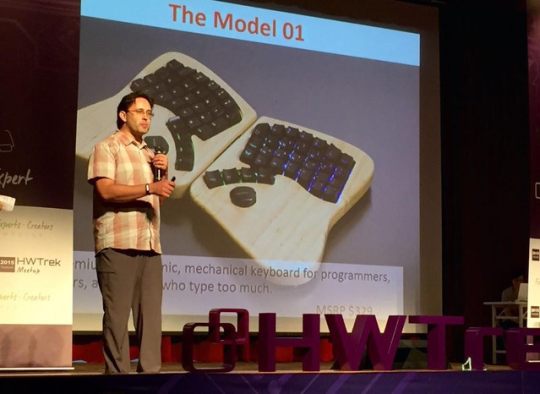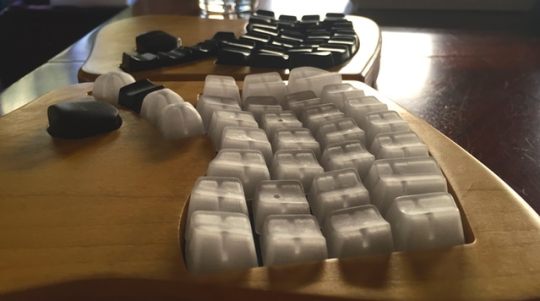Day 85: Back from China
When we last wrote about 5 weeks ago, we told you that things were slowly getting back to normal in Keyboardio-land. That was a little overly optimistic. What we probably should have said was that we were slowly beginning to learn that ‘normal’ would be a thing of the past.
If you’re just looking for product updates, skip down to the “Product Updates” section below. TL;DR: we’re still on track.
Upcoming appearances
We’ll be in Portland at the XOXO Festival this coming weekend. While we’re not exhibiting or speaking, if you see Jesse or Kaia, they’ll probably have a keyboard in their bag you could play with. They’ll also have some stickers for you.
The nice folks at Atmel have invited us to exhibit the Model 01 in their booth at World Maker Faire in New York on September 26th and 27th.
What we’ve been up to…
Shortly after returning from OSCON in Portland, Jesse hopped on a flight to Taipei to begin meeting potential manufacturing partners before the beginning of HWTrek’s 2015 Asia Tour. HWTrek helps connect startups and manufacturing partners. Their annual Asia Tour brings 20 startups to Taiwan and China to spend a very intense week visiting folks who can help hardware startups make their products a reality.

We had a few meetings scheduled before we got to Taipei. Once he got there, our friend Justin from TeX Keyboards helped Jesse set up meetings with four of the top keyboard original equipment manufacturers (OEMs) in Taiwan. Taiwan was the place to manufacture electronics back in the golden age of computer keyboards (the 1980s) and many of those companies are still around and looking for business.
Above: automatic keyswitch placement robot, hard at work.
There were two kinds of meetings. The first was more pleasant but decidedly less useful. In these meetings, the person across from Jesse was in sales and didn’t have engineers with them. Generally, those meetings went like this:
“Wow! Your keyboard is beautiful. The wood is just for the prototype, right? What would you think of switching to a nice white plastic? LEDs on every key? How about just a few LEDs and some light piping? Wait. You want to do custom keycaps? You know that costs money, right? And a programmable microcontroller? Oh, you’ll be providing the firmware for the microcontroller? That’s all right then.”
The “DFM meetings” were definitely the more intense experiences. There was still a salesperson in the room and generally they led the meeting, but really they were just there to facilitate questions from the engineers they’d brought with them. The usual team was an electrical engineer, a senior mechanical engineer and a junior mechanical engineer. In some cases, they’d studied a bid packet we’d sent them in advance and sometimes they were walking in cold.
In every case, they needed us to assert that the design was nearly final. Jesse would explain that what they had in front of them needed design for manufacturing (DFM) and that while there are aspects of the keyboard we’re unwilling to change, we’re generally happy to take their advice for how to make the keyboard better. After all, some of these folks have been designing and building keyboards for 30 years.
Justin also took Jesse to visit what we’re told is one of the longest-running keycap factories in Taiwan. It was a family business on the outskirts of Taipei with maybe 5 injection molding machines. While it wasn’t the first time we’ve seen keycaps being made, it was the first time either of us got to touch fresh keycaps “hot off the press.” In contrast to larger factories, they didn’t make their own injection molding tooling and didn’t do any of the post-processing like printing labels on the keys.
The next Monday, the official HWTrek program started. Along with folks from 20 other startups, we visited Jabil Green Point, a very high-end plastics factory; SGS’s Taipei testing and certification laboratory; pitched our products to executives and one of the cofounders of Quanta; walked through the Holux GPS testing lab; toured a large-scale circuit board manufacturer; and pitched our products to a gigantic room full of 450 OEMS, ODMs and CMs…all in the space of about 3 days.
After that, it was off to Beijing where we visited a Foxconn production line. (No, not one of the ones where they make hardware for “the fruit company from Cupertino.”) Foxconn also showed us their own testing labs. In addition to doing the radio interference testing we saw at SGS in Taipei, we got to see the lab with their 'drop testing’ setup. That’s where a poor, much abused cellphone is automatically dropped from a 1 meter height onto concrete over and over and over again. It’s also the home of the machines that brutally bend and twist phones back and forth for hours at a time, just to make sure that when you sit down with your phone in your back pocket nothing all that bad happens.
In Beijing, we also got to visit Xiaomi.
As we were waiting for the elevators up to Xiaomi’s offices, some of their engineers were clearly a little confused about what a busload of tourists was doing in their lobby. So, as we got into the elevator, Jesse pulled out the Model 01 prototype and started to show them what it can do. By the 5th floor, someone had pointed out that he was actually doing an elevator pitch. By the time we got off on the 12th floor, he’d handed out all the Keyboardio stickers in his pocket.

We were there for a meeting with their smart-home division CTO. If you don’t know Xiaomi, it’s understandable – they’re not selling phones in the US yet. They are, however, the #1 smartphone maker in China. Their stuff is…really, really nice. And it’s inexpensive. They’ve recently started to expand into connected devices, mostly by partnering with startups. Many of the other participants on the HWTrek tour were really natural fits for what Xiaomi is doing, but we weren’t really expecting the visit to be anything more than an opportunity to fanboy a really, really interesting company. We went around the room pitching our products. Jesse was a little surprised to actually get a question from the CTO.
“So, does it do Dvorak?”
After Beijing, we made our way to Shenzhen. With a population of over 10 million, it’s one of the five largest cities in China. In 1980, Shenzhen was a 300,000 person fishing village. If you have electronics that were made in China, chances are that they were made in or near Shenzhen.
The HWTrek program in Shenzhen was just a single day. First we visited a prototyping factory which specializes in making mockups of phones and kitchen appliances. If you wanted them to make a (non-working) mobile phone mockup that looked and felt like the real thing, it’d take about 5 days and cost you about $700.
After that, we visited Sunrex, the world’s biggest maker of laptop keyboards. Because customer products were being assembled, weren’t permitted to take photos of their automated assembly systems, QA setup or test lab. Suffice it to say that they had some very, very nice toys.
After the end of the HWTrek tour, Jesse spent another week in Shenzhen visiting factories and meeting with potential manufacturers. One of the highlights was finally getting to visit a CNC wood shop in Shenzhen that believe they can make our enclosures at a competitive price. They also assured us that by sealing the wood after milling it, we shouldn’t have to worry about the climate-related cracking issues we’ve been stressing about. They’ll be sending us samples within the next few weeks.
Product Updates
Manufacturing
Right now, we have detailed quotes/estimates from 4 of the 10 manufacturers we’re expecting to receive them from. The numbers we’re getting back are in line with what we’d expected based on pre-Kickstarter discussions. So far, no one manufacturer is clearly “the right answer”: it’s a little bit of a Goldilocks problem. Some of the factories are a little too big. Some are a little too small. We’re also starting to talk to a few manufacturers in the US, but aren’t super hopeful due to the large amount of manual labor involved in assembling keyboards. US vendors we’ve talked to in the past have told us that they tend to send most of their mechanical keyboard assembly overseas.
That’s not to say that we don’t have any good options, just that we’re still balancing tradeoffs.
To stay on schedule, we likely need to pick a manufacturing partner by the end of September. We believe we’re in a good position to do that.
Mechanical design
Over the past week, we’ve begun work on the promised update to our mechanical design. That will involve a tweak to the butterfly shape to make the keyboard a bit sturdier and a bit narrower, improvements to the interconnect system, relocating the USB port to improve enclosure durability, and design of the feet.
Keycaps
While he was in Shenzhen, Jesse visited StrongD, our prototyping shop, and picked up the next iteration of our keycap design. In comparison to the Kickstarter prototype, these keys have slightly smaller keytops and we’ve resculpted some of the harder-to-reach keys to make them a bit less of a stretch. We’ve got some more work to do before we’re happy, but these are definitely a step in the right direction.

Electrical design
For the Kickstarter prototypes, the way we rigged up the under-key LEDs was to use a two-PCB “sandwich.” It worked well enough, but was expensive to make and a pain to assemble. We’d always planned to find something better for production, but over the past month, we’ve found out that there may actually be a patent issue with that design, too.
Thankfully, we have several design options that will be less expensive to make, higher quality and, hopefully, brighter. One option involves sticking with “chip” style programmable LEDs and a clever PCB layout. Another involves switching to a “reverse-mount” LED with a separate controller chip. We’re working through evaluating the options now. The reverse-mount LEDs have a better repairability story but are proving to be nearly impossible to source.
We’re also looking at switching the chips that listen for keystrokes (sometimes known as I/O expanders, I/O multiplexers, or key scan engines). The chip we used for the Kickstarter prototypes required 5 volt to 3 volt conversion circuitry and made us to do a lot of the heavy-lifting ourselves. We’ve found a better chip from another vendor that should do a lot more of the key scanning on its own, runs at 5 volts and is significantly cheaper. We’ve built out the first crazy jury-rigged prototype to test the chip. So far, so good.
As we make these changes, we’re also taking the opportunity to clean up our PCB layout to make it easier to test, easier to repair, and to add a way for you to access all of the microcontroller’s pins (as you might on a regular Arduino.)
Buy a Model 01
The Kickstarter campaign’s over, but you can still pre-order a Model 01 to be delivered from our first production run. Just head on over to http://shop.keyboard.io. The post-Kickstarter price for the quiet click model is $329, but if you’ve read this far, the discount code IREADTHENEWSLETTER will take $10 off your order.
Shipping update
As of now, we believe we’re still on track to ship Model 01s to backers in April 2016.
<3 j+k
